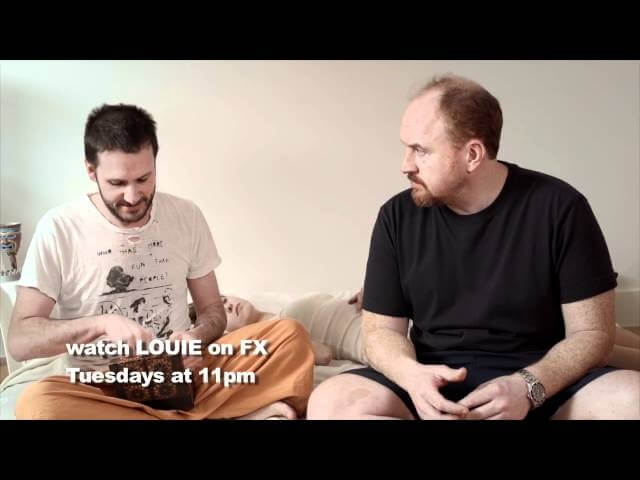Head up high, feet on the ground: 16 onscreen drug trips that don’t go over the top

1. Louie’s wasted afternoon: Louie, “Dogpound” (2010)
It isn’t easy to visually replicate the singular, internal experience of being high, which is why television and movies usually default to a handful of tropes: psychedelic imagery, weird camera angles and cuts, and often, overblown histrionics and hilariously off-base sequences like Helen Hunt throwing herself through a window after trying PCP. Although these techniques are somewhat useful for depicting the stoned mindset, they’re rarely used as deftly as they need to be to really capture the nebulous nature of a chemically altered state. Trying to make an onscreen drug trip realistic and funny (to someone other than the person who’s high, that is) presents a whole other set of challenges, which the first-season Louie episode “Dogpound” rises to admirably. Sure, Louis C.K.’s first time smoking weed in years involves its share of jumpy editing and weird imagery, but it’s combined in a way that reflects how confusing and distracting simple things can become after a giant bong rip of quality bud—things like whether that dog’s been there the whole time, and wasn’t he brown and white before? Louie’s obnoxious stoner neighbor doesn’t make things easy on him, either, offering vague, hard-to-track observations—not to mention a pull of vodka to help “even him out”—and once he brings out the “motor bong,” Louie’s grip on reality all but disappears, dissolving into a series of half-memories and bewildering images. Perhaps most realistic of all, though, is how little fun Louie has on his trip, which turns out to be a less-than-ideal way of counteracting the depression he battles throughout the episode.
2. Jesse tries heroin: Breaking Bad, “Mandala” (2009)
AMC’s chemistry-teacher-turned-meth-kingpin drama is composed of a series of personal low ebbs, but “Mandala” finds its core cast in some of the deepest valleys of Breaking Bad’s run. The episode opens with the death of a supporting player, a development that leads Walter White to make a Faustian bargain with buttoned-down devil Gustavo Fring. It’s all enough to make a shattered person like Jesse Pinkman (Aaron Paul) grope for a way to take the considerable edge off, an itch his recovering junkie girlfriend, Jane (Krysten Ritter), reluctantly scratches. Adam Bernstein’s direction pays long, lingering attention to the process of shooting up, simultaneously conveying Jesse’s anxiety about trying heroin and Jane’s meticulous, practiced attention to the particulars. What follows borders on hallucinatory cliché, but it’s salvaged by the sequence’s overriding sense of euphoria. The choice of soundtrack—The Platters’ gossamer “Enchanted”—goes a long way toward contributing to that sensation, while the sight of a writhing Jane below a levitating Jesse keeps one foot planted in reality. “Mandala” accurately conveys the escape heroin represents to someone like Jesse, illustrating along the way why he and Jane would risk dependency and possible overdose just to feel that bliss for a short while.
3. Lindsay tries marijuana: Freaks And Geeks, “Chokin’ And Tokin’” (2000)
Some people don’t react well to marijuana, and Freaks And Geeks’ Lindsay Weir (Linda Cardellini) is one of those people. In “Chokin’ And Tokin’,” Lindsay experimentally smokes some of the weed her boyfriend Nick (Jason Segel) has given her before remembering that she agreed to babysit the neighbor’s kid. Anxiety and paranoia set in, so Lindsay recruits her level-headed friend Millie (Sarah Hagan) to watch over the kid (whom Lindsay senses can tell she’s high) while she reads up on the effects of cannabis in the encyclopedia, reassuring herself that she probably won’t die. After contemplating the universe and reminiscing about old times with Millie, Lindsay finds solace in a bowl of cereal. Real-life lesson: Don’t get high before you have to do anything even remotely important.
4. ’Shrooming in Vegas: Knocked Up (2007)
As demonstrated in Freaks And Geeks, Judd Apatow tends to take a pretty grounded approach to the effects of drug use. In Knocked Up, Ben (Seth Rogen) and Pete (Paul Rudd) initially have a great time on mushrooms in Vegas, as they check into a swanky hotel, don suits, and enjoy a show, all while demonstrating that hallucinogens don’t necessarily turn the user into a gibbering, tripped-out fool. However, Cirque du Soleil proves to be too much for Ben, and the two end up back in the room, where they contemplate their love lives while scrutinizing the wide selection of chairs. In Apatow’s world, drugs are something smart, decent people can sample without ruining their lives, but also something that can’t be fully enjoyed when responsibility looms.
5. Cemetery acid trip: Easy Rider (1969)
The build-up to the famed cemetery acid-trip sequence in Easy Rider, shot on the fly and without permission in New Orleans’ St. Louis #1 cemetery, helps sell the verity of a bad LSD experience as much as the chaotic blur of jump cuts, in-camera effects, and Method wailing on display. Peter Fonda and Dennis Hopper’s bikers wind up in the cemetery on the tail end of an all-night bender that begins with the two boozing down Bourbon Street in the afternoon and evening, and continues the next morning, when they pick up two hookers (Karen Black and Toni Basil) at a brothel and head off to the cemetery to drop acid together. Already disoriented and blitzed from a wild night on the town, Fonda, Hopper, and their two guests are particularly susceptible to the drug’s effects, which here have a weeping Fonda referring to a Catholic statue as his mother, and the ladies touching the gravestones in sensual delight. Local Catholics were not amused by the hippie desecration: The archdiocese was so outraged by the stolen footage that no features were ever allowed to shoot in St. Louis #1 again.
